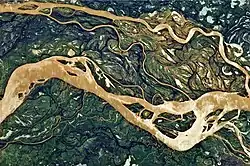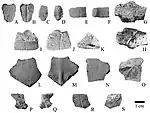Guabirotuba Formation
The Guabirotuba Formation is a late Middle Eocene (Divisaderan in the SALMA classification) geologic formation of the Curitiba Basin in Paraná, Brazil. The formation crops out in and around the city of Curitiba and comprises mudstones and sandstones deposited in a fluvial floodplain environment.
| Guabirotuba Formation | |
|---|---|
| Stratigraphic range: Late Mid Eocene (Divisaderan) ~ | |
| Type | Geological formation |
| Underlies | alluvium |
| Overlies | Cambrian basement |
| Thickness | 60–80 m (200–260 ft) |
| Lithology | |
| Primary | Mudstone, sandstone |
| Other | Conglomerate |
| Location | |
| Coordinates | 25.5°S 49.3°W |
| Approximate paleocoordinates | 27.5°S 39.8°W |
| Region | Paraná |
| Country | |
| Extent | Curitiba Basin |
| Type section | |
| Named for | Guabirotuba, Curitiba |
| Named by | Salamuni & Bigarella |
| Year defined | 1962 |
 Guabirotuba Formation (Brazil) | |
The 60 to 80 metres (200 to 260 ft) thick formation has provided several fossil mammals, and indeterminate side-neck turtle fossils, and indeterminate terror bird fossils. A newly described species of Cingulata; Proeocoleophorus carlinii was also found in the formation.
Description
The Guabirotuba Formation was first described by Riad Salamuni and João José Bigarella in 1962. The geologists named the formation after Guabirotuba, a neighborhood of Curitiba, the capital of Paraná State.[1] The formation is the lowermost sedimentary unit in the 3,000 square kilometres (1,200 sq mi) Curitiba Basin, a Cenozoic continental rift basin of southeastern Brazil,[2] overlying Cambrian basement comprising gneisses, amphibolites and migmatites of the Atuba Complex and metasediments of the Açungui Group.[3][4]
Lithologies

The 60 to 80 metres (200 to 260 ft) thick Guabirotuba Formation comprises a basal conglomerate,[5] mudstones and sandstones,[3] deposited in a fluvial floodplain environment.[2][6]
The sediments of the formation contain between 0.24 and 2.61% heavy minerals.[7] Heavy mineral analysis on the very abundant zircons, abundant epidote, common tourmaline and kyanite and rare rutile has provided insight in the paleocurrents of the fluvial environment, with predominant flow directions towards the northwest and east-northeast.[8]
Age
The age of the formation has been a matter of debate, with early descriptions assigning the formation to the Miocene to Pliocene,[6] but after the discovery of a mammal fauna described by Sedor et al. in 2017, the age of the formation has been defined as late Middle Eocene, or "Barrancan", which is a sub-age of the Divisaderan South American land mammal age,[note 1] ranging from approximately 42 to 39 Ma.[10][11]
Paleontological significance
The Guabirotuba Formation is one of few formations in Brazil providing Paleogene mammal faunas, between the older Tiupampan Maria Farinha Formation of the Parnaíba Basin and the Itaboraian Itaboraí Formation of the Itaboraí Basin in Rio de Janeiro State, and the younger Tinguirirican Entre-Córregos Formation of the Aiuruoca Basin and the Deseadan Tremembé Formation of the Taubaté Basin.[2]
Fossil content
Fossils recovered from the formation include:[12]
| Class | Group | Fossils | Images | Notes |
|---|---|---|---|---|
| Mammals | Dasypodidae | Machlydotherium sp. | [12] | |
| Meteutatus sp. | [12] | |||
| Parutaetus sp. | [12] | |||
| Utaetus sp. | [12] | |||
| Astegotheriini indet. | [12] | |||
| Euphractinae indet. | [12] | |||
| Cingulata | Proeocoleophorus carlinii | [12] | ||
| Notoungulata | Oldfieldthomasiidae indet. | [12] | ||
| Notopithecidae indet. | [12] | |||
| Astrapotheria | Astrapotheria indet. | [12] | ||
| Paucituberculata | Palaeothentoidea indet. | [12] | ||
| Sparassodonta | Nemolestes sp. | [12] | ||
| Theriiformes | Argyrolagoidea indet. | [12] | ||
| Birds | Phorusrhacidae | Phorusrhacidae indet. | [13] | |
| Reptiles | Turtles | Pleurodira indet. |  | [14] |
See also
- Abanico Formation, contemporaneous fossiliferous formation of Chile
- Macarao Formation, contemporaneous formation of Colombia
- Soncco Formation, contemporaneous fossiliferous formation of Peru
Notes and references
Notes
- The sub-ages "Barrancan" and "Vacan" are based on respectively the Gran Barranca Member and the Cañadón Vaca section of the Sarmiento Formation in Patagonia, Argentina and are not formally established;[9] some authors consider the "Barrancan" as the upper age of the Casamayoran[10]
References
- Monteiro Machado, 2012, p.564
- Sedor et al., 2017, p.39
- Da Silva Felipe, 2011, p.12
- Monteiro Machado, 2012, p.565
- Da Silva Felipe, 2011, p.17
- Monteiro Machado, 2012, p.566
- Monteiro Machado, 2012, p.567
- Monteiro Machado, 2012, p.570
- Woodburne et al., 2014, p.19
- Bellosi & Krause, 2014, p.31
- Woodburne et al., 2014, p.7
- Guabirotuba Fauna at Fossilworks.org
- Sedor et al., 2014, p.807
- Wagner Rogério et al., 2012, p.44
Bibliography
- Bellosi, Eduardo S., and J. Marcelo Krause. 2014. Onset of the Middle Eocene global cooling and expansion of open-vegetation habitats in central Patagonia. Andean Geology 41. 29–48. Accessed 2019-03-04.
- Monteiro Machado, Denise Alessandra; Luiz Alberto Fernandes; Ana Maria Góes; Maria José de Mesquita, and Fabio Macedo de Lima. 2012. Proveniência de sedimentos da Bacia de Curitiba por estudos de minerais pesados. Revista Brasileira de Geociências 42. 563–572. Accessed 2019-03-04.
- Sedor, Fernando A.; Édison V. Oliveira; David D. Silva; Luiz A. Fernandes; Renata F. Cunha; Ana M. Ribeiro, and Eliseu V. Dias. 2017. A New South American Paleogene Land Mammal Fauna, Guabirotuba Formation (Southern Brazil). Journal of Mammalian Evolution 24. 39–55. Accessed 2017-10-26.
- Sedor, Fernando A.; Eliseu Vieira Dias; Renata Floriano Da Cunha, and Herculano Alvarenga. 2014. Paleogene phorusrhacid bird (Aves, Phorusrhacidae) from the Guabirotuba Formation, Curitiba Basin, Paraná, South of Brazil, 807. 4th International Palaeontological Congress. Accessed 2019-03-04.
- Da Silva Felipe, Rogério. 2011. Características Geológico-Geotécnicas na Formação Guabirotuba Erosão - Movimentos Gravitacionais de Massa, 1–48. MINEROPAR. Accessed 2019-03-04.
- Wagner Rogério, Daniel; Eliseu Vieira Dias; Fernando Antonio Sedor; Luiz Carlos Weinschütz; Lucas Del Mouro, and Breno Leitão Waichel. 2012. Primeira ocorrência de Pleurodira (Testudines) para a Formação Guabirotuba, Bacia de Curitiba, Paraná, Brasil. Gaea 8. 42–46. Accessed 2019-03-04.
- Woodburne, M.O.; F.J. Goin; M. Bond; A.A. Carlini; J.N. Gelfo; G.M. López; A. Iglesias, and A.N. Zimicz. 2013. Paleogene Land Mammal Faunas of South America; a Response to Global Climatic Changes and Indigenous Floral Diversity. Journal of Mammalian Evolution 21. 1–73. Accessed 2019-02-15.